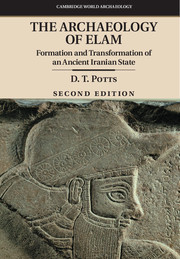Book contents
- Frontmatter
- Dedication
- Contents
- List of illustrations
- List of tables
- Preface to the second edition
- Preface and acknowledgements
- Acknowledgements for photographic reproduction
- List of abbreviations
- Note on transliteration and dating systems
- 1 Elam: what, when, where?
- 2 Environment, climate and resources
- 3 The immediate precursors of Elam
- 4 Elam and Awan
- 5 The dynasty of Shimashki
- 6 The grand regents of Elam and Susa
- 7 The kingdom of Susa and Anshan
- 8 The Neo-Elamite period
- 9 Elam in the Achaemenid empire
- 10 Elymais
- 11 Elam under the Sasanians and beyond
- 12 Conclusion
- References
- Index
4 - Elam and Awan
Published online by Cambridge University Press: 18 December 2015
- Frontmatter
- Dedication
- Contents
- List of illustrations
- List of tables
- Preface to the second edition
- Preface and acknowledgements
- Acknowledgements for photographic reproduction
- List of abbreviations
- Note on transliteration and dating systems
- 1 Elam: what, when, where?
- 2 Environment, climate and resources
- 3 The immediate precursors of Elam
- 4 Elam and Awan
- 5 The dynasty of Shimashki
- 6 The grand regents of Elam and Susa
- 7 The kingdom of Susa and Anshan
- 8 The Neo-Elamite period
- 9 Elam in the Achaemenid empire
- 10 Elymais
- 11 Elam under the Sasanians and beyond
- 12 Conclusion
- References
- Index
Summary
Although Elam may be mentioned as early as 3000 BC in the so-called Archaic texts from Uruk in southern Mesopotamia, it is not attested unambiguously in the historical record until the middle of the third millennium BC when it appears, in the Sumerian King List, as an adversary of the Sumerian city-state of Kish. A second Iranian region, known as Awan, also makes its appearance in a similar context at this time. Thereafter, both Awan and Elam are mentioned in a variety of Mesopotamian sources dating to the mid and late third millennium BC. After reviewing the literary evidence, we examine those contemporary archaeological remains from Khuzistan and the central western Zagros which have the greatest likelihood of representing the material equivalent of third millennium Elam and Awan. The use of the terms ‘Trans-Elam’ and ‘Trans-Elamite’ to describe a much more easterly portion of the Iranian Plateau and its material culture is also examined.
During the period from c. 2350 to 2150 BC we continue to see Elam largely through Mesopotamian eyes (see in general Álvarez-Mon 2013a). This was the time of the Old Akkadian dynasty in southern Mesopotamia which was founded by Sargon of Agade and ruled from an as yet unidentified capital in central Iraq. Elam figures in Old Akkadian royal inscriptions and literary works, though some of these are known only from much later copies. Repeated acts of aggression against Elam and Susiana are recorded, and the subjugation of Susa by the Akkadians is confirmed by a number of sources. It is interesting to examine the material culture of a site like Susa in light of its political history at this time. Slightly later, around 2100 BC, we are able to chart the rise and progress of an indigenous leader, Puzur-Inshushinak, the first Elamite (or Awanite) since the mid-third millennium BC to attack Mesopotamia itself. The question of whether Puzur-Inshushinak's short-lived consolidation of power in this period should be seen as a response to Mesopotamian aggression – in other words as a case of ‘secondary state formation’ – is considered, as is the significance of the so-called Linear Elamite inscriptions associated with Puzur-Inshushinak.
Introduction
In the middle of the third millennium BC, two eastern regions, Elam and Awan, appear in Mesopotamian cuneiform sources. In this chapter we shall first examine the earlier written sources from c.
- Type
- Chapter
- Information
- The Archaeology of ElamFormation and Transformation of an Ancient Iranian State, pp. 79 - 122Publisher: Cambridge University PressPrint publication year: 2015



